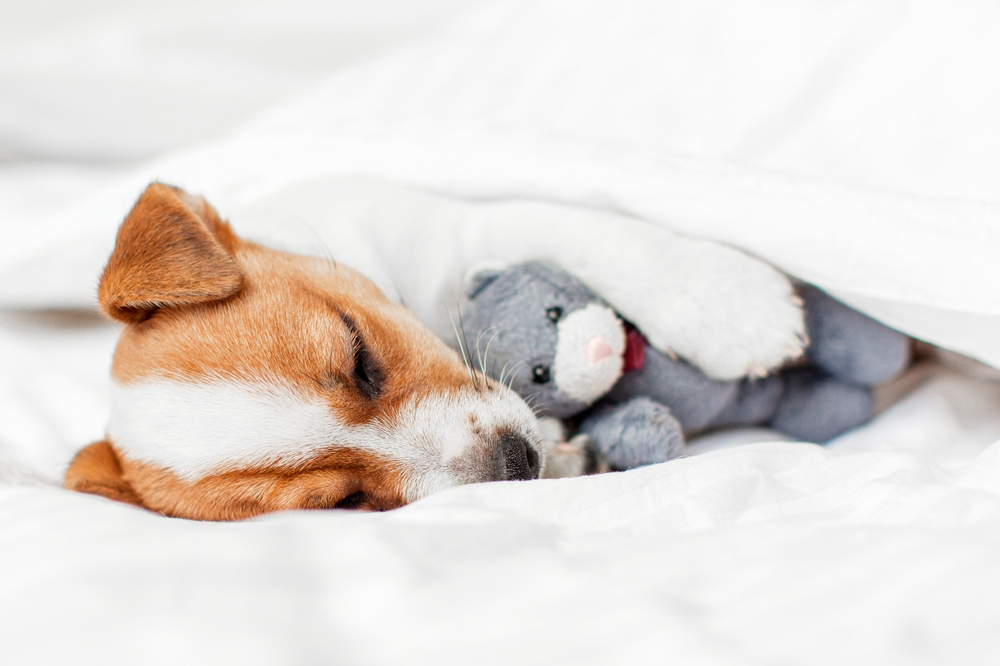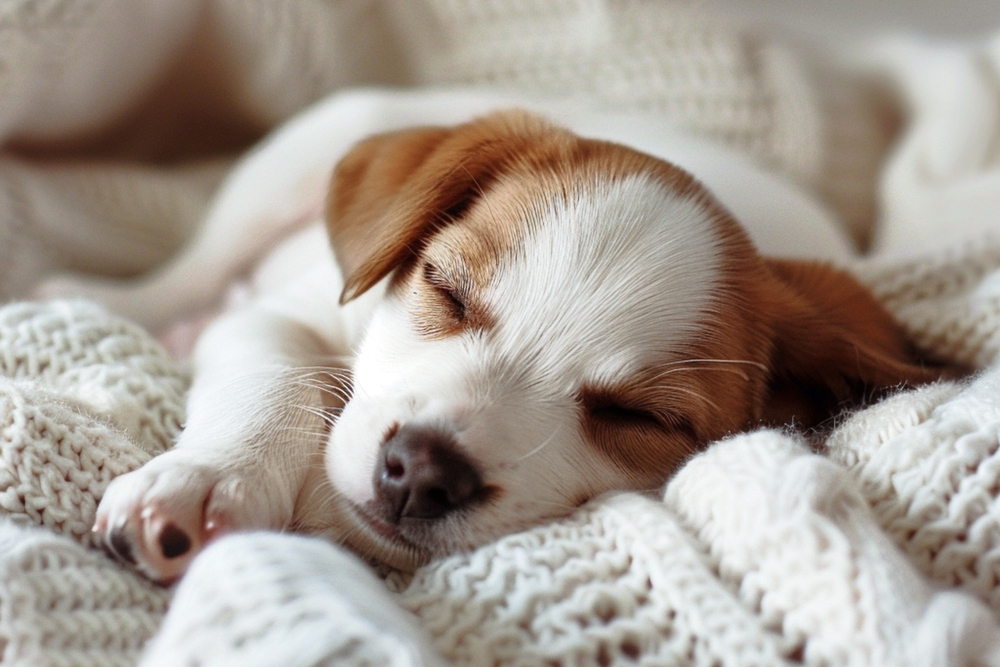Yes, it’s possible for dogs to experience nightmares, although we can’t know for sure what their dreams are about. Like humans, dogs experience REM (Rapid Eye Movement) sleep, which is the stage of sleep when dreaming occurs. During REM sleep, dogs’ brains are active, and their bodies may exhibit physical signs like twitching, whimpering, or rapid eye movement under their eyelids.
While we can’t directly ask a dog what they’re dreaming about, it’s believed that the content of a dog’s dreams could be related to their experiences or daily activities, much like it is for humans. So, a dog might dream about things that stress them out or negative experiences, leading to what we interpret as nightmares.
Signs that a dog may be having a bad dream or nightmare could include:
- Whimpering or growling
- Twitching of the paws, legs, or face
- Rapid eye movement (under the eyelids)
- Restlessness or even jerky movements

These behaviors are more likely to occur during the REM stage of sleep, and while it’s hard to say exactly what a dog is dreaming about, it’s possible that they could be reliving a traumatic event, or they may just be having a vivid dream based on their daily experiences. However, most of the time, dogs simply wake up from these episodes and recover quickly, going back to sleep peacefully.
If a dog frequently shows signs of anxiety during sleep or seems particularly distressed by its dreams, it could be worth talking to a vet, as this might indicate an underlying issue like anxiety or a medical problem.
What Do Dogs Dream Of?

Dogs, like humans, spend a significant portion of their sleep in REM (Rapid Eye Movement) sleep, the phase of sleep where dreaming occurs. During REM sleep, the brain is active, and their bodies can exhibit signs that they’re dreaming—like twitching, jerking movements, or even making noises like whining or barking softly. These physical cues give us a clue that something is going on in their minds, but understanding the content of their dreams is more speculative.
While we can’t directly know what’s happening in a dog’s dream, several factors suggest that their dreams are closely linked to their daily lives, similar to human dreams.
1. Playful Dreams
It’s likely that dogs dream about things they love to do—chasing, playing, or exploring. Imagine a dog dreaming of running through a field, chasing after a ball or a frisbee. Their paw movements or twitching while asleep may reflect these dream activities. Just as humans often dream about events that are tied to our passions or hobbies (like a basketball player dreaming of scoring a game-winning shot), dogs may dream about their favorite activities, whether that’s fetching a ball, playing with another dog, or interacting with their human family members.
2. Chasing Dreams
One of the most common behaviors seen in dreaming dogs is paw twitching or running movements. This suggests that dogs may dream about chasing something—whether it’s a ball, a squirrel, or another animal. The act of running or chasing may be ingrained in a dog’s instinctual behaviors, and in their dreams, they may be replaying moments of pursuit or exploration. Chasing, especially for hunting or play, is deeply rooted in canine nature, so it makes sense that this might be a frequent dream theme.
3. Social Interactions
Dogs are highly social animals, so it’s likely that many of their dreams involve other animals or humans. Dogs might dream about interactions with their pack members—whether it’s playing with other dogs, interacting with their human family members, or perhaps even confronting or playing with animals they encounter in real life, such as cats or squirrels. Dogs who are particularly attached to their owners might have dreams that focus on their bond, where they might dream of cuddling, playing, or just being with their humans.
4. Food-Related Dreams
Given how much dogs love food, it wouldn’t be surprising if they dream of delicious meals! A dog may dream of eating their favorite treat, receiving scraps from the dinner table, or even hunting down a tasty snack. If a dog has a particularly strong food drive, they might experience food-related dreams in the same way that people dream about eating or seeking out food in times of hunger or desire.
5. Fearful or Stress-Induced Dreams
While many dog dreams are likely pleasant, it’s also possible for dogs to have nightmares. If a dog has had negative experiences—like a traumatic event at the vet, a loud thunderstorm, or an encounter with a fear-inducing animal—those experiences may replay as distressing dreams. This could explain why some dogs whimper, growl, or even act out in their sleep. The anxiety and fear they feel when awake could manifest in their dreams, potentially causing them to react physically as they “live” through these frightening scenarios.
6. Memories and Repetitive Behavior
Dogs are creatures of habit, and their dreams might reflect their routines or repetitive behaviors. For example, a dog that always goes for walks at a particular time of day may dream about the walk itself—the smells, sights, and sounds of the walk could be vivid in their dreams. Likewise, a dog who is frequently taken to a dog park might dream about the other dogs they meet there or their favorite spots within the park. These repetitive experiences could become familiar dream themes for them.
7. Repetitive Dreams from Training
Dogs that are trained for specific tasks, such as service dogs, working dogs, or even well-trained pets who know commands like “sit,” “stay,” or “fetch,” might have dreams where they are practicing or performing these behaviors. The positive reinforcement they receive from mastering a task or following a command could be incorporated into their dreams. It’s possible that a dog might dream of fetching a ball and receiving praise afterward, reinforcing their sense of success and satisfaction.
8. Dreams and Aging
As dogs age, they may experience changes in their sleep patterns. Older dogs sometimes have more frequent, vivid dreams, and these can be influenced by physical conditions such as arthritis, anxiety, or cognitive dysfunction syndrome (similar to dementia in humans). In these cases, older dogs might have dreams that are disoriented, confused, or unsettling. These dreams could reflect the dog’s struggle with their physical or mental health, leading to behaviors like whining, pacing, or restlessness during sleep.
9. Scientific Studies and Theories
A study done on rats (which, like dogs, are mammals) showed that they replay actions they’ve learned during the day in their sleep, specifically during REM sleep. This suggests that dogs, like other mammals, may also replay their daily experiences in their dreams. Dogs may dream about recent events or interactions, such as a fun walk in the park or playing with their favorite toy.
Though we can’t know for certain, it seems clear that dogs’ dreams are a reflection of their daily lives—their favorite activities, their interactions with humans and other animals, and even their fears or anxieties. Just like humans, they may dream about familiar experiences, feelings, or instincts that are important to them.
From running after a ball in a wide-open field to confronting a fear-inducing noise or event, dogs’ dreams likely mirror the wide range of emotions and experiences they have during the day. In the end, while we can’t fully enter their dream world, watching a dog twitching or “chasing” in their sleep gives us a glimpse into their dreamscapes—and a reminder of how deeply connected they are to us, and to the world around them.
How to Soothe Your Dog After a Nightmare

How to Soothe Your Dog After a Nightmare
1. Stay Calm and Reassuring
Your dog can sense your emotions, so remain calm and composed. Speak to them in a soft, soothing voice to help them feel safe.
2. Gently Wake Them Up
If your dog is still visibly distressed or agitated, gently call their name or softly touch them to help them wake up. This can help break the cycle of the nightmare and bring them back to reality.
3. Provide Comforting Physical Contact
Offering gentle petting or cuddling can reassure your dog and help them feel secure. Some dogs feel more comforted by being held or laying next to their owner during these times.
4. Offer a Calm Environment
After the nightmare, make sure the area around them is quiet and peaceful. Dim the lights or create a calm atmosphere to prevent any further stress.
5. Redirect Their Focus
Once your dog is awake and calm, distract them with a favorite toy, a treat, or a short walk. This can help shift their focus and prevent them from lingering on the scary feelings from the nightmare.
6. Ensure a Comfortable Sleeping Area
Make sure your dog’s bed or sleeping area is cozy and safe. If they have trouble sleeping, consider adjusting their sleeping environment with familiar scents (like a blanket or your clothing) or a calming pet-safe diffuser.
7. Monitor for Ongoing Anxiety
If your dog seems to have frequent nightmares or displays signs of ongoing anxiety, it may be a good idea to consult a vet or a pet behaviorist. They can help assess whether there are underlying issues contributing to your dog’s nightmares.
By providing comfort and a sense of security, you can help your dog feel safe and supported after a frightening dream.

